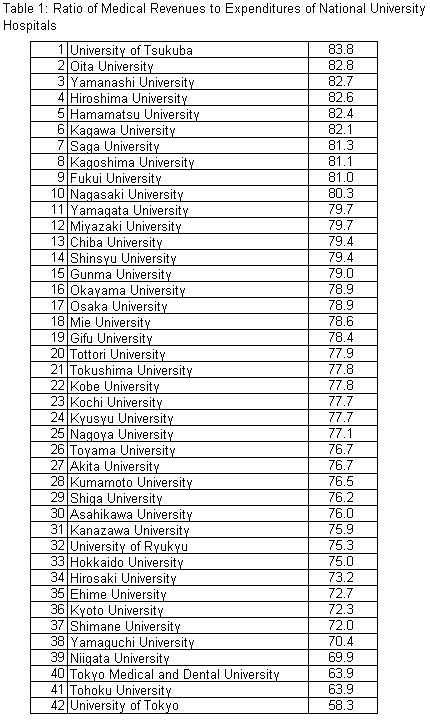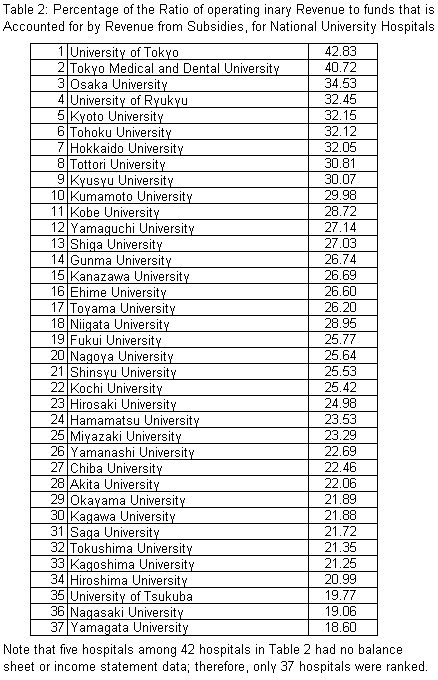Introduction
It has been decided that national universities shall be shifted to independent, nonpublic corporation status, as from April 2004. In October of this year, the Ministry of Education, Culture, Sports, Science, and Technology released draft mid-term targets and plans for 89 national universities and junior colleges that have been slated for privatization. Although some of these universities had indicated fixed numerical targets and were attempting to adopt management concepts, most had simply lined up inoffensive comments. The reason for this is that the condition of the universities, as well as the flow of funds (operational subsidies), after privatization are still unclear. In particular, since universities with hospitals rely on medical revenues and subsidies for most of their revenues, there is the danger that one mistake could lead to bankruptcy. For this reason, they must be increasingly cautious.
According to the "New Image of Privatization of National Universities" issued by the Ministry of Education, Culture, Sports, Science, and Technology on March 26, 2002, following the privatization of universities, "Educational research institutions, such as university hospitals and others, shall be considered to be part of the universities, based on the fact that such facilities have been considered, up until now, to have inseparable relationships with the educational research activities of those universities." However, the same report also notes, "Based on factors including actual circumstances of operation and the possibility of independent profitability, certain university facilities shall be made independent from the national universities for the sake of more flexible management. These shall be established as separate types of corporations and, as necessary, the national university corporations may invest in these corporations."
Perhaps in response to this, Nagoya University says it plans to embark on a reorganization next spring that will detach the examination and research sections of its School of Medicine, increasing the independence of its university hospital. It is currently making arrangements to shift the budgeting and personnel authority of its university hospital from the Dean of the School of Medicine to the Director of the Hospital. A harbinger of steps toward the independence of university hospitals that face conversion to independent administrative institutions next spring, this is the first time a national public university in Japan has separated off its examination and research sections.
It seems that the national universities have also begun to make significant changes. Regarding this matter, I have tried to rank university medical school hospitals ("medical hospitals") and dental school hospitals ("dental hospitals") based on certain indices of management.
Hospitals ranked by ratio of medical revenues to expenditures
Table 1 shows the results of this ranking. The University of the Tsukuba was ranked first among medical hospitals, followed by Oita University and Yamaguchi University, in that order. On the other hand, among dental hospitals, Osaka University had the best business performance, followed by Tokyo Medical and Dental University and Niigata University, in that order. However, all hospitals achieved ratios of less than 100%, indicating that no national university hospital is operating in the black.
This would seem to be due to the fact that national university hospitals provide medical services together with their educational and research facilities and thus do not receive their income entirely from medical revenues. As a result, national university hospitals receive large fund transfers from general accounts. Table 2 shows what percentage of these universities' operating revenues to fund accounted for by revenue from subsidies. Among medical hospitals, the University of Tokyo was the highest at 42.8%, followed by Tokyo Medical and Dental University and Osaka University. The interesting point about this table is the fact that universities with a low ratio of medical revenue to expenditure, in general, showed that a high percentage of their ratio of operating reveues was accounted for by revenue from subsidies. That is to say, national universities offset negative medical revenues with tax revenues. Even so, nine university hospitals with insufficient funds are in a state of insolvency (a state in which total liabilities exceed total assets). Among these, Osaka University Hospital is in a state of financial crisis, with an equity ratio of less than -35%. If it were a private firm, it would not be unusual for it to be transferred to the Resolution and Collection Corporation. When we consider the fact that Osaka University's dental hospital has an equity ratio of 30.2%, we can see the contrast between the circumstances of the university's medical and dental hospitals. Although there is currently a nationwide trend toward consolidation of medical hospitals with dental hospitals, it appears that for the top dental hospital in terms of business performance, the Osaka University Dental Hospital, consolidation with the university's medical hospital would not necessarily be advisable. The same could be said for Tokyo Medical and Dental University. Wisely, both these universities have not chosen to consolidate their medical hospitals with their dental hospitals.
Proof of responsibility is required
Until now, redevelopment efforts and acquisition of advanced medical devices at national university hospitals were conducted as part of national government policy. Traditionally, under the national budget, the funds needed to pay for such measures were borrowed from public funds using increased revenues from such enhanced facilities as collateral. Currently, the Ministry of Education, Culture, Sports, Science, and Technology pays back public funds by calculating a reimbursement amount, corresponding to the amount borrowed, for each of the 42 universities with university hospitals, and reimburses the total amount for the 42 universities in one lump-sum payment from hospital revenues.
But how long can this arrangement continue? Hypothetically speaking, if national university hospitals were to have a higher proportion of patients with severe illnesses than private university hospitals, they should probably make such circumstances clear to the public by calculating a Case Mix Index under the Diagnosis Procedure Combination (DPC) system that was launched in April of this year. As demands are made for them to be placed on an equal footing with private medical universities, even national university hospitals must take steps to improve the ratio of their medical revenues to their expenditures.



